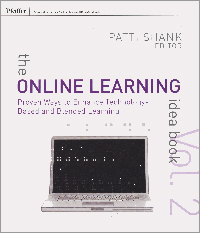When Volume 1 of The Online Learning Idea Book appeared in 2007, reviewers praised it for its focus on practical, innovative, tried-and-tested ideas from practitioners in the field. Volume 2 is, in my opinion, even better.

A huge storehouse of ideas
Patti Shank, who edited Volume 1, has collected enough ideas to fill almost 400 pages: five chapters, with a total of 83 ideas that dozens of collaborators provided. An array of illustrations – 70 figures and 24 exhibits – accompanies the ideas.
The chapters organize the ideas into logical areas that make it easy for designers and developers to find solutions for those problems that come up so often in the creation of online materials. The chapters address ideas for:
- The design and development process
- Supporting learners and learning
- Synchronous and social learning
- Self-paced learning
- Media and authoring
Within each chapter, all the ideas follow a common presentation format:
- The
Big Idea
- What: A short description of the idea, enough to help you decide if it’s what you need.
- Why: A brief explanation of the value and benefits of the idea.
- Use
It!
- How: A more detailed description of the idea, its implementation, and tips for use.
- Adopt or Adapt: Ideas to help get you started adapting the idea to your situation.
- Attribution (The originators of the idea, and their contact information)
The ideas will work on their own, and you will find that many of them would make ideal combinations. Here are a few of the idea topics:
- Online? Yes, No, Maybe So
- Better Collaboration with Your Subject-Matter Expert
- Story-Based Learning
- Team Review Form
- My Personal Learning Network
- Learning Log
- Virtual Job Interviews
- Polling for Engagement
- YouTube YouTalk
- Wiki Review
- Branched Scenarios with Three Cs and Placeholder Content
- Talking Head Video, CNN-Style
- Simulate It
- Pecha Kucha for Learning
- Word Clouds
- Creating a Slide Replay Button in Captivate 5
Who this book is for, and how to use it
Shank is clear that she has the practitioner in mind, whether that practitioner is a designer, an authoring tool user, or someone who performs both functions. However, as she points out, there are several ways to use the book.
An individual designer or developer can easily use it as a source book. There is plenty of margin space for handwritten notes and for sticky notes and flags.
Teams of designers can use the book as a reference when developing their standards and protocols for dealing with typical client requirements, and as a basic framework for communicating among themselves about particular solutions.
If you are teaching others to design online learning, this would make a wonderful textbook. Because it is so practical in its approach, you can easily organize discussions and projects around the ideas and not be in danger of getting too “academic” in your deliberations. The same is true of initiatives intended to teach methods for multimedia development, use of technology in the classroom, and for leading faculty development workshops.
Finally, many of the ideas, particularly in Chapter 5, relate to particular media and authoring tools: PowerPoint, Captivate, Articulate Presenter, Articulate Quizmaker, Flash!, and more.
Recommendation
I’ll just cut to the chase here: Get this book. Use it.
Book Details
Shank, Patti (Ed.). (2011) The Online Learning Idea Book, Volume 2: Proven Ways to Enhance Technology-Based and Blended Learning. San Francisco: Pfeiffer. 378 pages. ISBN 978-0-470-47230-9
Available from:
Pfeiffer: $60.00
Amazon: $50.66 (paperback), $22.54 (Kindle)
Barnes & Noble: $50.66 (paperback), $48.00 (Nook)


